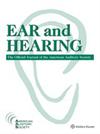Audiogram Estimation Performance Using Auditory Evoked Potentials and Gaussian Processes.
IF 2.6
2区 医学
Q1 AUDIOLOGY & SPEECH-LANGUAGE PATHOLOGY
引用次数: 0
Abstract
OBJECTIVES Auditory evoked potentials (AEPs) play an important role in evaluating hearing in infants and others who are unable to participate reliably in behavioral testing. Discriminating the AEP from the much larger background activity, however, can be challenging and time-consuming, especially when several AEP measurements are needed, as is the case for audiogram estimation. This task is usually entrusted to clinicians, who visually inspect the AEP waveforms to determine if a response is present or absent. The drawback is that this introduces a subjective element to the test, compromising quality control of the examination. Various objective methods have therefore been developed to aid clinicians with response detection. In recent work, the authors introduced Gaussian processes (GPs) with active learning for hearing threshold estimation using auditory brainstem responses (ABRs). The GP is attractive for this task, as it can exploit the correlation structure underlying AEP waveforms across different stimulus levels and frequencies, which is often overlooked by conventional detection methods. GPs with active learning previously proved effective for ABR hearing threshold estimation in simulations, but have not yet been evaluated for audiogram estimation in subject data. The present work evaluates GPs with active learning for ABR audiogram estimation in a sample of normal-hearing and hearing-impaired adults. This involves introducing an additional dimension to the GP (i.e., stimulus frequency) along with real-time implementations and active learning rules for automated stimulus selection. METHODS The GP's accuracy was evaluated using the "hearing threshold estimation error," defined as the difference between the GP-estimated hearing threshold and the behavioral hearing threshold to the same stimuli. Test time was evaluated using the number of preprocessed and artifact-free epochs (i.e., the sample size) required for locating hearing threshold at each frequency. Comparisons were drawn with visual inspection by examiners who followed strict guidelines provided by the British Society of Audiology. Twenty-two normal hearing and nine hearing-impaired adults were tested (one ear per subject). For each subject, the audiogram was estimated three times: once using the GP approach, once using visual inspection by examiners, and once using a standard behavioral hearing test. RESULTS The GP's median estimation error was approximately 0 dB hearing level (dB HL), demonstrating an unbiased test performance relative to the behavioral hearing thresholds. The GP additionally reduced test time by approximately 50% relative to the examiners. The hearing thresholds estimated by the examiners were 5 to 15 dB HL higher than the behavioral thresholds, which was consistent with the literature. Further testing is still needed to determine the extent to which these results generalize to the clinic. CONCLUSIONS GPs with active learning enable automatic, real-time ABR audiogram estimation with relatively low test time and high accuracy. The GP could be used to automate ABR audiogram estimation or to guide clinicians with this task, who may choose to override the GP's decisions if deemed necessary. Results suggest that GPs hold potential for next-generation ABR hearing threshold and audiogram-seeking devices.使用听觉诱发电位和高斯过程的听力图估计性能。
目的 听觉诱发电位(AEP)在评估婴儿和其他无法可靠参与行为测试者的听力方面发挥着重要作用。然而,将 AEP 从更大的背景活动中区分出来是一项具有挑战性且耗时的工作,尤其是在需要进行多次 AEP 测量(如听力图估算)的情况下。这项任务通常委托给临床医生,他们通过目测 AEP 波形来确定是否存在反应。缺点是这给测试带来了主观因素,影响了检查的质量控制。因此,人们开发了各种客观方法来帮助临床医生检测反应。在最近的工作中,作者引入了具有主动学习功能的高斯过程(GPs),利用听觉脑干反应(ABRs)进行听阈估计。高斯过程对这项任务很有吸引力,因为它可以利用不同刺激水平和频率的听觉脑干反应波形的相关结构,而传统的检测方法往往会忽略这一点。具有主动学习功能的 GP 之前在模拟 ABR 听力阈值估计中被证明是有效的,但尚未在受试者数据中对听力图估计进行评估。本研究以听力正常和听力受损的成年人为样本,评估了具有主动学习功能的 GPs 在 ABR 听力图估算中的应用。方法使用 "听阈估计误差 "评估 GP 的准确性,"听阈估计误差 "的定义是 GP 估算的听阈与对相同刺激的行为听阈之间的差异。测试时间是通过定位每个频率的听阈所需的预处理和无伪影历时数(即样本大小)来评估的。检查人员严格遵守英国听力学学会提供的指南,通过目测进行比较。22 名听力正常的成年人和 9 名听力受损的成年人接受了测试(每名受试者一只耳朵)。结果GP 的中位估计误差约为 0 dB 听力水平 (dB HL),显示出相对于行为听力阈值的无偏测试性能。与考官相比,GP 还能将测试时间缩短约 50%。检查员估计的听阈比行为听阈高 5 到 15 dB HL,这与文献报道一致。仍需进一步测试,以确定这些结果在多大程度上适用于临床。GP 可用于自动 ABR 听力图估算或指导临床医生完成这项任务,临床医生可在必要时选择推翻 GP 的决定。结果表明,GP 有潜力成为下一代 ABR 听力阈值和听力图搜索设备。
本文章由计算机程序翻译,如有差异,请以英文原文为准。
求助全文
约1分钟内获得全文
求助全文
来源期刊

Ear and Hearing
医学-耳鼻喉科学
CiteScore
5.90
自引率
10.80%
发文量
207
审稿时长
6-12 weeks
期刊介绍:
From the basic science of hearing and balance disorders to auditory electrophysiology to amplification and the psychological factors of hearing loss, Ear and Hearing covers all aspects of auditory and vestibular disorders. This multidisciplinary journal consolidates the various factors that contribute to identification, remediation, and audiologic and vestibular rehabilitation. It is the one journal that serves the diverse interest of all members of this professional community -- otologists, audiologists, educators, and to those involved in the design, manufacture, and distribution of amplification systems. The original articles published in the journal focus on assessment, diagnosis, and management of auditory and vestibular disorders.
 求助内容:
求助内容: 应助结果提醒方式:
应助结果提醒方式:


